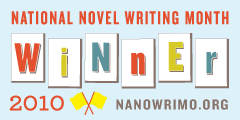Lesson Plans and Resources for Script Frenzy
March 13, 2011
 If you are thinking of challenging students to take part in the Young Writers Program (YWP) for Script Frenzy, you’ll want some resources to support the project.
If you are thinking of challenging students to take part in the Young Writers Program (YWP) for Script Frenzy, you’ll want some resources to support the project.
As I explained in more detail yesterday, Script Frenzy is the free event that asks writers to spend April writing a script for a screenplay, stage play, TV show, short film, comic, or graphic novel.
The YWP site has information for teachers that includes lesson plans for all age levels walk students through the basic tasks from setting their goals to building conflict and developing dialogue. You can even apply to borrow computers for classroom use during the month—deadline March 15, so hurry!
Help students find the focus for their scripts by trying one of these ReadWriteThink lessons (plus one from Thinkfinity partner EDSITEment):
- Bring a historical character to the present day with History Comes Alive: Using Fluency and Comprehension Using Social Studies (grades 2–5). The lesson focuses on Benjamin Franklin, but you could adapt the idea to any historical figure or period.
- Create a fan fiction script after examining an existing television show with Media Literacy: Examining the World of Television Teens (grades 6–8).
- Compose a radio script for a recently-read short story or novel with Audio Broadcasts and Podcasts: Oral Storytelling and Dramatization (grades 9–12).
- Focus on a voice from the past with Giving Voice to Child Laborers Through Monologues (grades 6–8). The monologue students compose can be broken out and distributed in a longer script, used as of a one-person show, or kept as is to serve as a soliloquy in a longer script. This basic technique could be adapted to any time period and speakers from the past, present, or future.
- Ask students to create a script that focuses on sharing an important message with the audience with MyTube: Changing the World With Video Public Service Announcements (grades 9–12). Point families interested in helping with the project to the family resource MyTube: Make a Video Public Service Announcement (grades 7–12).
- Focus on inquiry and research by asking students to script a documentary on a famous woman with Scripting the Past: Exploring Women’s History Through Film (grades 9–12).
- Share a movie scene with no dialogue and ask students to create a script for that scene with Writing a Movie: Summarizing and Rereading a Film Script (grades 3–5). Students can go on to create a longer script that explores a subplot or scenes that have not been included in the original film.
- Have students create an alter ego and compose scripts for that persona’s radio show with Alter Egos and More with Avi’s "Who Was That Masked Man, Anyway?" (3–5).
- If students are working on comics or graphic novels, for instance, be sure to try The Comic Book Show and Tell (grades 9–12) lesson to help them sharpen their word choice. Use the Comic Vocabulary Interactive to explore the genre in more detail.
Cross-posted to the Reading and Language Arts Discussion Group in the Thinkfinity Community and to the NCTE Community ReadWriteThink eGroup and Graphic Novels eGroup.


